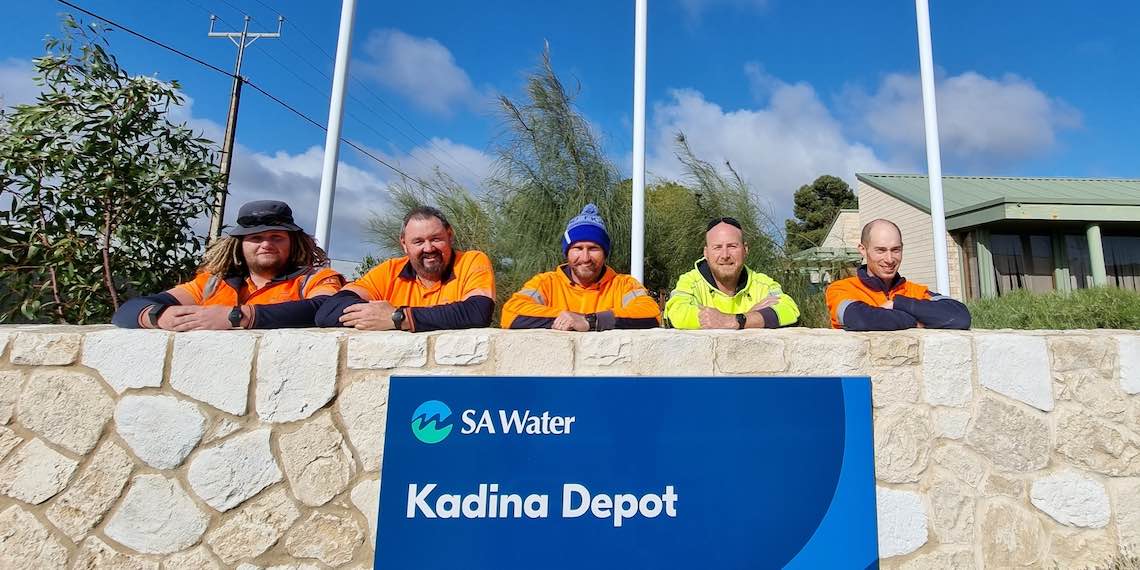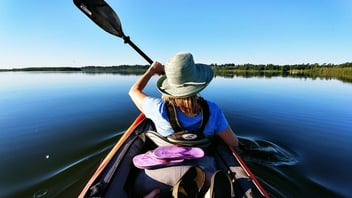New tech trial set to transform workplace health and safety

Health and safety in the water sector may soon enter a new era thanks to an innovative study using wearable technology to track employees' physiological data for greater insight into workplace health and wellbeing.
SA Water has teamed up with researchers from the University of South Australia to pilot the new study, which involves 15 of the utility’s field-based staff wearing smart devices, which collect data that will be analysed to identify opportunities for early detection and intervention of potential safety issues.
Wristband sensors and smart shirts are among the devices now being tested by staff from SA Water's Kadina Depot, along with trade waste and water sampling teams. In-sole sensors are also on the horizon.
SA Water General Manager of People and Safety Kylie Johnson said the safety initiative could have broad application across the utility’s state-wide workforce, and potentially the broader water community, too.
“With a vast water network, our people are often performing challenging physical tasks in a range of weather conditions and our trial will explore how technology can improve their health and wellbeing,” she said.
“Working together with the University of South Australia, our people will undertake specific work activities, such as driving prolonged distances and pipe maintenance to explore how their bodies respond, measure their vital signs and monitor the effect of heat, fatigue and sleep.
“Excitingly, the wearable devices provide the opportunity to capture mental and physical wellbeing insights we haven’t been able to in the past.”
The wristband sensors worn by the utility’s Kadina staff quantify sleep deprivation and the resulting effect on alertness, focus and mental health, while the biometric smart shirts monitor the cardiac and respiratory system to capture greater knowledge about physical strain.
“All of these collective insights can lead to improved situational awareness and allow certain work activities to be altered, postponed or optimised, creating better safety outcomes for our people,” Johnson said.
Filling the research gap
Project lead, University of South Australia Research Professor Jill Dorrian, said findings from the study could set a new precedent for proactive safety practices in the water sector.
“Our research continues to find that issues such as fatigue and sleep are prevalent across industries and can often increase the risk of workplace incidents, but our trial could open the door for the use of innovative technologies that support an even more proactive approach to safety and wellbeing,” she said.
“Literature from researchers overseas demonstrates the use of wearable devices can increase employee satisfaction, while providing early detection and intervention for improved decision-making around how physical tasks are performed or managing individual workload to avoid burnout.”
SA Water Media, Communications and Strategic Engagement Senior Manager Joshua Zugajev said that while there have been early explorations in the UK into how wearable devices could deliver useful health and safety data, there’s still work to do in translating data into practical outcomes for water professionals working in Australia.
“We want to take this area of research to the next level and translate it into practical guidance around how work practices could be enhanced. But also, there is a need to explore the data within our own local context,” he said.
The South Australian climate and geography is diverse, as is the range of tasks SA Water staff complete, so the trial will be collecting data from staff engaged in a broad range of in-field tasks within different environmental contexts.
“We now have a team of people across three different business units, including field operations, pipelines maintenance and trade waste, who are helping us test this wearable technology,” he said.
“All of these activities are different, and will be testing different scenarios and work activities. It also means we are testing different types of geography and climate as well.”
Next level safety
Zugajev said that SA Water staff have a great safety mindset and the utility is aware that getting ahead of emerging hazards requires thinking about safety from a design perspective.
“When we design assets and processes, designing out hazards from the start is very effective. It delivers really tangible results. Our people have seen for themselves that avoiding hazards and incidents in the first place is the best approach to ensuring safety,” he said.
“The really cool outcome from collecting this kind of data is that it may help us prevent exposure to risk at an individual level. Getting extra insights into the physiological reactions our staff have within different circumstances may help us detect people at risk of danger due to fatigue.
“There’s the potential that we could intervene to prevent any harm from occurring.”
Furthermore, Zugajev said using all of the data sets could result in more predictive works planning to increase safety and productivity.
“Knowing how people's bodies react at certain times of the day, in certain temperatures and doing certain activities can help us schedule works based on those insights to achieve peak outcomes, while keeping people safe,” he said.
“But there is also potential for intervention as well. There is the potential to generate alerts or warning mechanisms that ensure staff are aware of emerging risks, or potentially detect when an employee might need assistance.”
Zugajev said the trial is important to SA Water due to the utility's commitment to ensuring the safety of its employees and the development of better safety and wellbeing measures.
“Our business is very large and integrated. We provide services within all the water sector scenarios. The study is a great testing ground to see what data all the possible scenarios produce,” he said.
“We have people that need to complete work out in environments with very variable factors. There are often other people present, as well as machinery and equipment, animals, and of course the weather. There are lots of different types of hazards.”
Zugajev said that while the whole water sector is very much focused on designing out, reducing or controlling hazards as much as possible, it’s important to continue to pursue more sophisticated and beneficial work safety outcomes for staff.
“The fact is that many of our staff are still exposed to hazards and many of them are hazards we will never be able to fully design out or prevent,” he said.
“We need to continually stay on top of the ways we can improve, learn more and reduce and help manage risks that are there.”


